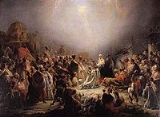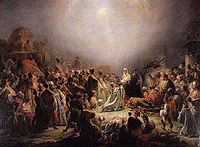
Domingos Sequeira
Encyclopedia
Domingos António de Sequeira (10 March 1768 – 8 March 1837), was a Portuguese
painter
.

, into a modest family. He later changed his family name from Espírito Santo to the more aristocratic Sequeira. He studied art first at the academy of Lisbon, before moving to Rome
, were he was Antonio Cavallucci
`s pupil.
By the age of thirteen, he had evinced such marked talent that F. de Setubal employed him as assistant in his work for the João Ferreiras Palace. Sequeira sojourned in Rome from 1788 to 1794, when he was made honorary member of the Academy of St Luke. After another two years and study in Italy, he returned to his native country preceded by so great a reputation that important commissions for churches and palaces were immediately entrusted to him: scriptural subjects, large historical compositions and cabinet pictures.
In 1802 he was appointed first court painter, in which capacity he executed many works for the prince regent, for Dona Maria Teresa, and for the members of the court. He designed the valuable silver service which was presented by the Portuguese nation to Wellington
, and a monument that was erected in 1820 in the Rossio square at Lisbon. In 1823 he visited Paris, where he is known to have tried his skill in lithography
and etching
. In 1825, he painted the "Death of Camões", by many considered the first proto-romantic or romantic Portuguese painting. The last years of his life he spent in Rome, devoting himself chiefly to devotional subjects and to his duties as head of the Portuguese Academy. He saw a Turner exposition in the late 1820s, that inspired him some of his best paintings, like the "Adoração dos Magos" (1828). He died in Rome in 1837.
, the convent of Laveinas, the new palace of Ajuda
, and in the principal palaces and churches of Lisbon. The Museu Nacional de Arte Antiga (National Museum of Ancient Art), in Lisbon, has one of the best collections of his paintings.
Portugal
Portugal , officially the Portuguese Republic is a country situated in southwestern Europe on the Iberian Peninsula. Portugal is the westernmost country of Europe, and is bordered by the Atlantic Ocean to the West and South and by Spain to the North and East. The Atlantic archipelagos of the...
painter
Painting
Painting is the practice of applying paint, pigment, color or other medium to a surface . The application of the medium is commonly applied to the base with a brush but other objects can be used. In art, the term painting describes both the act and the result of the action. However, painting is...
.


Biography
He was born in Belém, LisbonLisbon
Lisbon is the capital city and largest city of Portugal with a population of 545,245 within its administrative limits on a land area of . The urban area of Lisbon extends beyond the administrative city limits with a population of 3 million on an area of , making it the 9th most populous urban...
, into a modest family. He later changed his family name from Espírito Santo to the more aristocratic Sequeira. He studied art first at the academy of Lisbon, before moving to Rome
Rome
Rome is the capital of Italy and the country's largest and most populated city and comune, with over 2.7 million residents in . The city is located in the central-western portion of the Italian Peninsula, on the Tiber River within the Lazio region of Italy.Rome's history spans two and a half...
, were he was Antonio Cavallucci
Antonio Cavallucci
Antonio Cavallucci was an Italian painter of the late Baroque.-Biography:Cavallucci was born in Sermoneta in the Lazio. His artistic talents were recognized in an early stage by Francesco Caetani, Duke of Sermoneta in 1738-1810...
`s pupil.
By the age of thirteen, he had evinced such marked talent that F. de Setubal employed him as assistant in his work for the João Ferreiras Palace. Sequeira sojourned in Rome from 1788 to 1794, when he was made honorary member of the Academy of St Luke. After another two years and study in Italy, he returned to his native country preceded by so great a reputation that important commissions for churches and palaces were immediately entrusted to him: scriptural subjects, large historical compositions and cabinet pictures.
In 1802 he was appointed first court painter, in which capacity he executed many works for the prince regent, for Dona Maria Teresa, and for the members of the court. He designed the valuable silver service which was presented by the Portuguese nation to Wellington
Arthur Wellesley, 1st Duke of Wellington
Field Marshal Arthur Wellesley, 1st Duke of Wellington, KG, GCB, GCH, PC, FRS , was an Irish-born British soldier and statesman, and one of the leading military and political figures of the 19th century...
, and a monument that was erected in 1820 in the Rossio square at Lisbon. In 1823 he visited Paris, where he is known to have tried his skill in lithography
Lithography
Lithography is a method for printing using a stone or a metal plate with a completely smooth surface...
and etching
Etching
Etching is the process of using strong acid or mordant to cut into the unprotected parts of a metal surface to create a design in intaglio in the metal...
. In 1825, he painted the "Death of Camões", by many considered the first proto-romantic or romantic Portuguese painting. The last years of his life he spent in Rome, devoting himself chiefly to devotional subjects and to his duties as head of the Portuguese Academy. He saw a Turner exposition in the late 1820s, that inspired him some of his best paintings, like the "Adoração dos Magos" (1828). He died in Rome in 1837.
Works
Among his best-known pictures are the "Flight into Egypt," "Ugolino," the "St Bruno at Prayer" at the Lisbon Academy, and the "Descent from the Cross." Numerous paintings by Sequeira are in the royal palace at MafraMafra, Portugal
Mafra is a town in Mafra Municipality in Portugal.The town is 28 km north-west from the center of Lisbon. It is mostly known for the sumptuous Palácio de Mafra , which also makes it a popular tourist destination in the Lisbon area...
, the convent of Laveinas, the new palace of Ajuda
Ajuda
Ajuda is a Portuguese civil parish in the municipality of Lisbon with an area and 17,961 inhabitants ; its density was 5707.3 inhabitants/km².-History:...
, and in the principal palaces and churches of Lisbon. The Museu Nacional de Arte Antiga (National Museum of Ancient Art), in Lisbon, has one of the best collections of his paintings.

